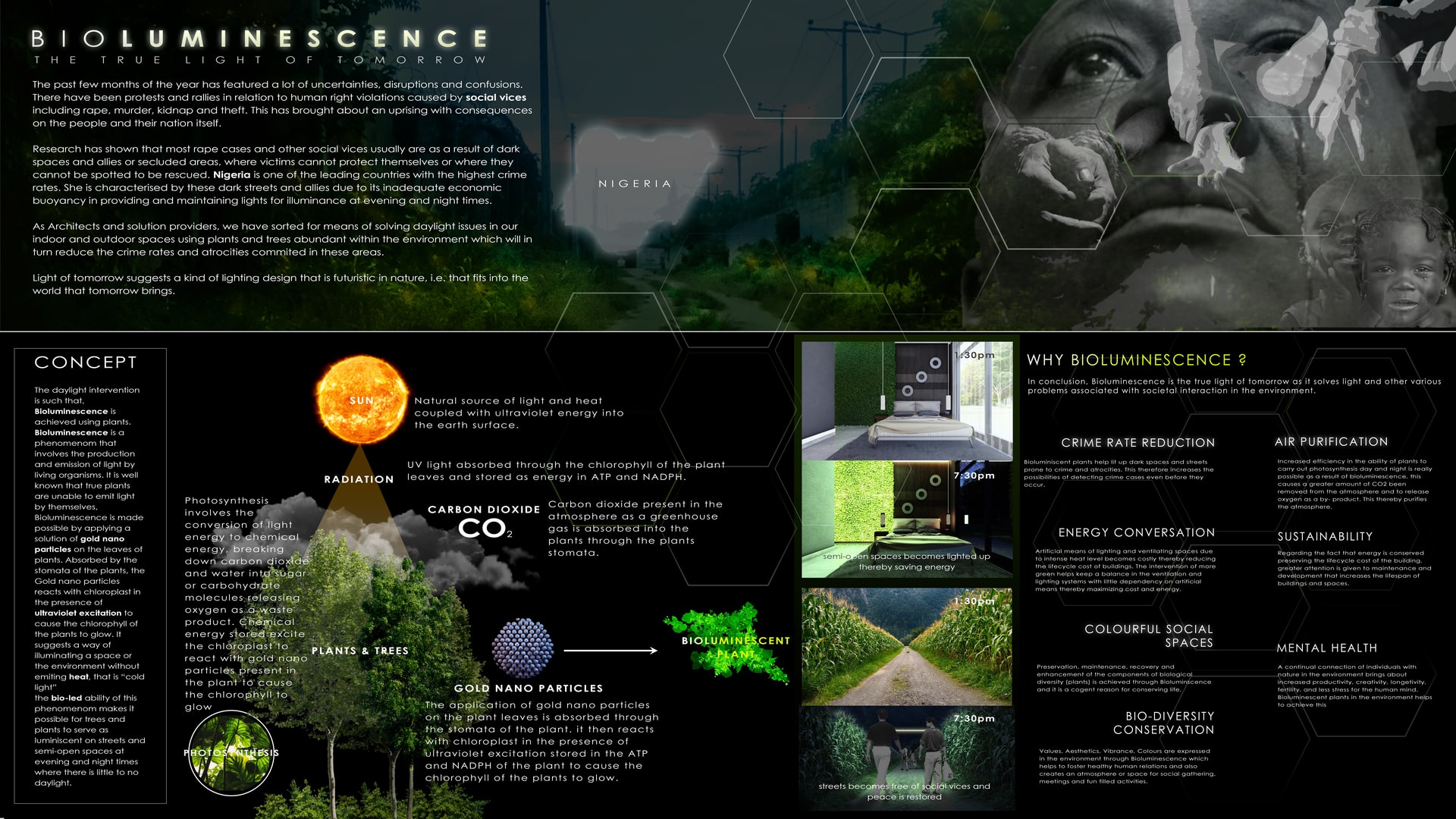Project Description
BIOLUMINESCENCE: THE TRUE LIGHT OF TOMORROW In more recent years, on a global perspective, the issue of crime has become alarming as it unveils its ugly mask in every society. Crimes involving rape, assault, homicide, theft, kidnap pose a serious threat to lives in the society. According to research, dark spaces and secluded areas are one of the prominent reasons for increase in crime rate. Nigeria, being known as one of the leading countries in high crime rates has dark spaces and secluded areas due to little or no access to quality, reliable and affordable lighting infrastructure. Lighting infrastructure are alternative means of solving daylighting issues in both our indoor and outdoor spaces as this would help to drastically reduce crime rate in our society. Hence, this study is focused on introducing an alternative means to solving daylighting issues using a natural, affordable and highly sustainable means. Bioluminescence as the true light of tomorrow is a phenomenon that involves the production of bio-chemical emission of light by living organisms like plants. In the real sense, true plants in themselves cannot emit light. Plants can only be made to be bioluminescent by applying a solution of Gold Nano particles on the leaves of the plants, which serve as carriers of stimulants that influences the plants to glow. The aim of this study is focused at illuminating outdoor or semi-open spaces without emitting heat using bioluminescence as the intervention for daylighting issues. This is achieved by using the bio-led ability of bioluminescence to illuminate the environment and semi-open spaces as plant and trees lit up in the evening and dark hours, thereby reducing crimes usually committed in dark. The study examined bioluminescence in plants and its benefits to humans and the human society at large. Such benefits include energy conservation, sustainability, reduction in crime rate, bio-diversity conservation, mental health, air purification, and colorful social spaces. The study made use of primary sources for collection of data such as journals, reports, articles from reliable past works related to bioluminescence in plants which was then critically analyzed to solve problems associated with illuminating outdoor and semi-open spaces. This analysis was carefully represented using graphical illustrations and presentations to communicate the idea. It is revealed through the sources that the Sun, which is the major source of daylight emits ultraviolet energy into the earth surface, then plants absorb this ultra-violet energy, which travels by radiation, though its green pigment chlorophyll. This energy is stored in the chlorophyll of the leaves as ATP and NADPH. Carbon dioxide is also absorbed by the plants from the atmosphere through its stomata. Solution of Gold Nano particles is introduced by spraying the leaves of the plant, which is then absorbed through its stomata. The absorbed Gold Nano particles reacts with the chloroplast of the plant in the presence of the ultraviolet excitation as photosynthesis takes place. Photosynthesis involves the conversion of ultraviolet light energy to chemical energy by breaking down the carbon dioxide and water, absorbed into the plant, into sugar/carbohydrate molecules. The reaction between the chloroplast and the Gold Nano particles is responsible for the ignition of the chlorophyll to glow, hence the plant illuminates. In conclusion, bioluminescence is the true light of tomorrow which brings us into the future, shows us what future holds from now through its lighting mechanism, as nature (plants) is made to glow. It helps to procure solution to the problem of lighting and other problems associated with societal interaction in the environment.
